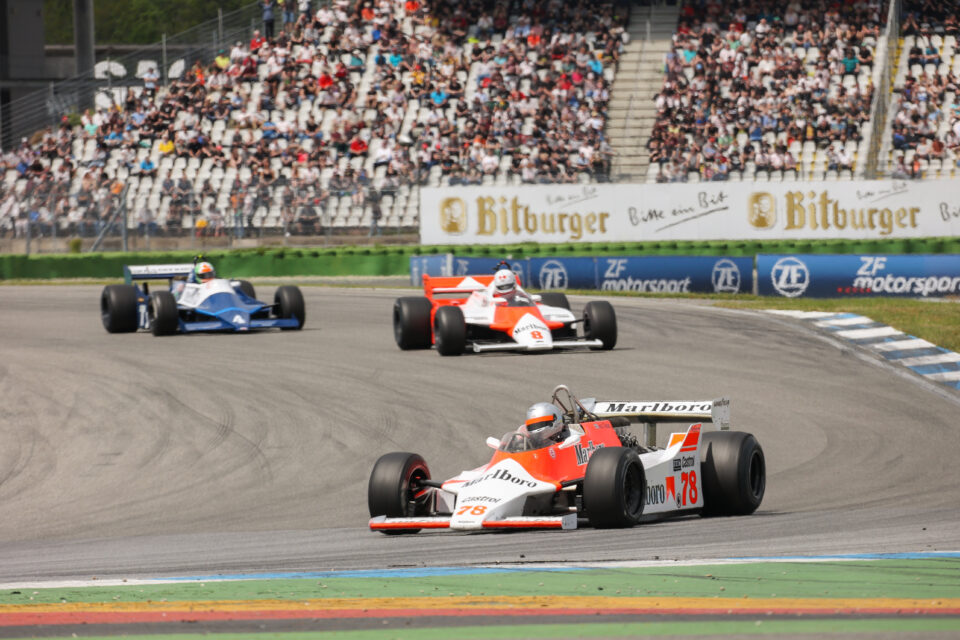- 20th edition of the Jim Clark Revival from 9th to 11th May at the Hockenheimring
- The ADAC Hockenheim Historic takes a look at six decades of Formula 1
- Why the cheapest Formula 1 engine was also the most successful
Every racing driver dreams of sitting in a Grand Prix car one day. The sound of engines and names like Fangio, Brabham, Clark, Stewart, Fittipaldi, Lauda, Prost, Senna, Schumacher, Hamilton and Verstappen make every motorsport fan’s eyes glaze over. Formula 1 is and remains the undisputed premier class of motorsport. At the ADAC Hockenheim Historic, the GP cars once again take centre stage, especially as the event commemorates one of the greatest Formula 1 drivers of all time and world champion of 1963 and 1965: Jim Clark.
It is therefore particularly fitting that the ‘Masters Historic Racing’ has found its way back to Baden after a one-year absence. Briton Ron Maydon founded the fascinating racing package, which now consists of ten different racing series, in 2004, thus realising a dream he had already had as a young boy. At the tender age of eleven, Ron set off on his bike from his home in Aylesbury to Brands Hatch, around 110 kilometres away, to experience his idol Jim Clark and the other Formula 1 heroes of the time live. The police put an abrupt end to the endeavour at the time and returned the young man to his parents’ care. Decades later, Ron Mayden revitalised his childhood dream by founding the ‘Masters Historic Racing’.
Cosworth DFV: £100,00 for the history books
Four of the MHR racing series will be competing at the ADAC Hockenheim Historic 2025, with the ‘Masters Racing Legends for 1966 to 1985 F1 Cars’ also representing the premier class here. This category is reserved for Formula 1 cars powered by a 3-litre naturally aspirated V8 engine. And this is primarily about the Cosworth DFV, which has become a true icon of Grand Prix history and is surrounded by a particularly exciting development history.
After the 1.5-litre engines previously used in Formula 1 gave way to the new 3-litre regulations at the end of 1965, the British teams in particular were faced with overwhelming competition from the V12 engines from Ferrari, Maserati and Honda. Lotus boss Colin Chapman, who had fallen behind with the weak and too heavy Coventry Climax engine, asked his former gearbox engineer Keith Duckworth for help. Together with Mike Costin, Duckworth had founded the engine manufacturer Cosworth and promised to develop a competitive, affordable engine for the private teams for the 1967 season on the then already meagre budget of £100,000. He kept his word. And how.
Over the next 19 years, the Cosworth DFV (the abbreviation stands for ‘Double Four Valve’), which initially produced around 450 hp and then more than 500 hp over time, was good for no less than 155 Grand Prix victories and 12 drivers’ world championship titles, making it not only the most cost-effective Formula 1 engine in history, but also the most successful. The ‘Masters Racing Legends for 1966 to 1985 F1 Cars’ trace this legendary history.
Formula racing from the early days to the modern era
But that’s not all the Formula 1 spectacle at the ADAC Hockenheim Historic. The ‘Historic Racecar Association’ has dedicated itself entirely to formula racing cars. Monopostos from various categories and years, from Formula Junior to the junior formulas 3 and 2, compete against each other here. The colourful single-seater hustle and bustle also includes the Grand Prix racers from the aforementioned years 1961 to 1965, which were powered by a 1.5-litre engine. This is precisely the period in which Lotus driver Jim Clark won his two world championship titles.
Two other racing series are dedicated to the premier class of motorsport. While the ‘Historic Grand Prix Car Association’ features racing cars from the early days of Grand Prix racing, i.e. from the 1920s through to the 1960s, the BOSS GP series builds a bridge to the modern era. In addition to Formula Renault and GP2 cars, the field also includes Formula 1 cars from Benetton, Toro Rosso and Lotus from the period after the turn of the millennium. During the presentation drives of Raceclub Germany – F1 Tradition on Track, Formula 1 cars from the 1980s, 1990s and 2000s can be seen in action, in particular two original Formula 1 cars from Toyota, namely Ralf Schumacher’s TF105 (2005) and Timo Glock’s TF108 (2008) from Team FNT.
Motorsport enjoyment on a budget
Of course, the ADAC Hockenheim Historic is not all about Formula 1 – sports and touring car enthusiasts will also get their money’s worth over the three days and a total of eleven racing series. And, as always, everything is available at family-friendly prices. The Friday ticket costs just 17 euros, the day tickets for Saturday and Sunday 39 and 34 euros respectively and the weekend ticket 54 euros. Including grandstand seating and paddock, of course. Pupils and students pay half price, children under 14 and wheelchair users are admitted free of charge. Tickets are available at the box offices or at www.hockenheim-historic.de.






